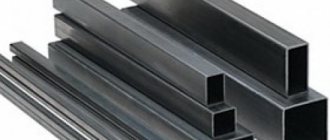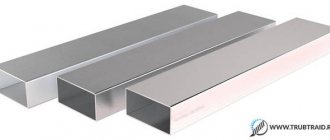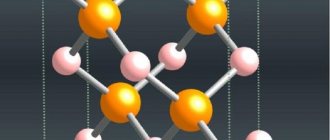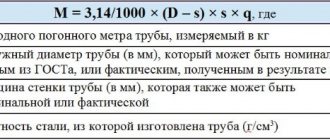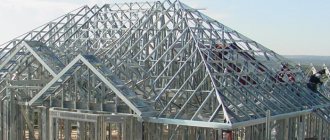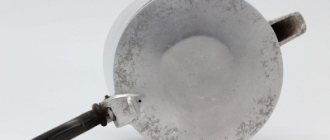A profile pipe made of aluminum is a hollow metal structure that is produced in a factory. The cross-sectional shape of such products is rectangular or square. Profile pipe is widely used in various industries. The diverse range and unique technical characteristics explain the wide distribution of these designs.
Light but durable structures for domestic and industrial purposes are created from aluminum profile pipes
Product standardization
The characteristics and production of rectangular profile pipes are regulated by several documents. The range of products is certified in accordance with GOST 22233 and standard 8617-81. Document 22233 gives the characteristics of profiles made from aluminum alloys by hot pressing, which are intended for use in translucent structures of structures and buildings.
Also an important document, which contains the classification of aluminum products, technical requirements, assortment, maximum dimensional deviations, conditions for acceptance and testing of pipes, is GOST 18475, approved in 1982. This standard applies to cold-formed structures intended for export and the national economy.
There are thin-walled (with a wall up to 0.05 * 100 mm) and thick-walled (with a wall more than 0.05 * 100 mm).
Where are aluminum pipes used?
There are several areas in which both round and rectangular aluminum tubes are successfully used:
- ventilation of premises;
- construction of residential buildings;
- pipelines;
- creation of drainage systems;
- coal industry;
- creation of simple metal structures (railings);
- Agriculture;
- oil industry.
Aluminum products are also often used in shipbuilding. Despite the fact that they are practically not used in creating water supply systems due to their carcinogenicity, they are used in many industries. An example is the creation of drainage systems. The popularity of such products is associated with the low cost and lightness of the material.
Such tubes can be used to create irrigation systems in garden plots. If they are created from aluminum with titanium, they can be used to create water supply systems. Often such products are used to create mountain bike frames.
Thanks to the lightness of the material, the finished structure is light and durable, which allows it to be used in extreme conditions. Titanium alloys are mainly used on an industrial scale, as they are expensive for the retail buyer. Advertising structures and stair railings are also made from aluminum.
Pipe classification
Standard 18475-82 provides classification of products. Thus, an aluminum pipe can be classified into one of the groups based on the following characteristics: cross-sectional shape and condition of the material.
Some types of pipes are processed using special technologies to improve strength properties and appearance
Note! According to the cross-sectional shape, round, rectangular, square and shaped pipes are distinguished. Conventional abbreviations KR, PR, KV and FS, respectively.
The condition of the material classifies pipes into:
- hardened;
- annealed;
- hardened and naturally aged;
- hardened and aged artificially;
- after hardening, cold-hardened and naturally aged;
- after hardening, cold-hardened and artificially aged.
Conditional abbreviations are H, M, T, T1, TH and T1H, respectively. The aluminum structure is made annealed and cold-worked from AB, D1 and AMg1 alloys, and hardened and naturally aged from D1 and AB.
Features of application for air conditioning systems
Copper is considered the traditional material for the production of air conditioner tubes, and for many consumers it may be a discovery that there is an alternative in the form of aluminum. Aluminum is approximately 2 times cheaper than copper; its use can significantly reduce the cost of connecting air conditioners. Why do many professionals still avoid using aluminum pipes for air conditioners?
Aluminum pipe after the necessary processing is used for air conditioners
The fact is that copper and aluminum react and corrosion occurs, which does not allow the use of aluminum products. However, modern technological solutions make it possible to cope with this problem. Aluminum tubes for air conditioners with copper tips have now become available for purchase. During their production, pieces of copper are welded to an aluminum tube using modern high-tech equipment using the intermolecular welding method.
The result is a reliable material for installing air conditioners at minimal cost. The attitude towards aluminum tubes for air conditioners is still quite skeptical, but users who decided to try them note the quality and significant savings.
Aluminum alloys for the manufacture of profile pipes
Rectangular aluminum structure is made from aluminum and its various alloys. The chemical composition is regulated by GOSTs:
- 4784-74 for D1, AB, AD31, AMg1, AMtsS, AMts;
- 11069-74 for A5.
Pipes are made from different alloys, the composition of which is clearly regulated by accepted standards
The characteristics of alloys of grades 1955 and AMg0.7 are regulated by separate regulatory and technical documentation. By agreement with the consumer, a rectangular pipe can be made from aluminum grades A85 and A8 according to document 11069-74.
The composition of resource materials for the manufacture of products (according to standard 4784) is given in the table. The numbers in the cells are the mass fractions of the elements, which are expressed in %. Each value must be divided by 1 thousand.
Table 1
| Brand | Si | Fe | Cu | Mn | Mg | Cr | Zn | Ti | Other items | Al, no less | |
| Every | Sum | ||||||||||
| AD0 | 250 | 400 | 50 | 50 | 50 | — | 70 | 50 | 30 | — | 99500 |
| AD1 | 300 | 300 | 50 | 25 | 50 | — | 100 | 150 | 50 | — | 99300 |
| AMtsS | 150- 350 | 250-450 | 100 | 1000- 1400 | 50 | — | 100 | 100 | 50 | 100 | The rest |
| AMts | 600 | 700 | 200 | 1000- 1500 | 200 | — | 100 | 100 | 50 | 150 | |
| AD31 | 200- 600 | 500 | 100 | 100 | 450- 900 | 100 | 200 | 150 | |||
| AMg1 | 300 | 700 | 200 | 200 | 500- 1100 | 100 | 250 | — | |||
| AB | 500- 1200 | 500 | 100- 500 | 150- 350 | 450- 900 | 250 | 200 | 150 | 50 | 100 | |
| D1 | 200- 800 | 700 | 3500- 4800 | 400- 1000 | 400 | 100 | 300 | 150 | 50 | 150 | |
Alloy D1 additionally contains Ti+Zr with a mass fraction of 0.2%. The chemical composition of alloys according to GOST 11069 is given in the table. All values are given in % and the indicators must be divided by 100.
table 2
| Brand | Si | Fe | Cu | Zn | Ti | Other mixtures (each separately) | Al, no less |
| A5 | 25 | 30 | 2 | 6 | 2 | 3 | 9950 |
| A85 | 6 | 8 | 1 | 2 | 0,8 | 2 | 9985 |
| A8 | 10 | 12 | 1 | 4 | 1 | 2 | 9980 |
PLEASE CHECK PRICES by calling (812) 931 5252 and (499) 390 5252
Dear customers! To avoid waiting for shipment at the warehouse, we ask you to pick up the selected goods only after receiving a notification to your email!
We try to save your time.
sells round aluminum pipes from warehouses in Moscow and St. Petersburg. To buy round aluminum pipes, as well as other products, please use the search by brand and size on our website or call
in Moscow
in St. Petersburg, 322-95-91.
From us you can buy aluminum round pipes of various sizes. The price for a round aluminum pipe is presented on the website. We carry out cutting of aluminum pipes to any size, retail sale, delivery to the address.
Duralumin pipe D16t, aluminum pipe AMG2, AMG3, AMG5, pipe AD31 is a hollow profile of different sections, made of aluminum and its alloys.
Aluminum pipe is distinguished by high performance characteristics: long service life, resistance to the destructive effects of corrosion and chemically aggressive substances, low weight and high strength.
The scope of application of aluminum pipes is quite wide - from road construction and oil production to public utilities. They are indispensable in the construction of ships, aircraft, cars and industrial equipment. They are successfully used in the manufacture of radiators, gas tanks, pipelines for fuels and lubricants, gas pipelines, water pipelines, heating systems, drainage systems and air ducts.
Aluminum pipe is made from the following grades of alloys: AMg2, AMgZ, AMgZS, AMg5, AMg60, AD31, AD35, AB, AD00, AD0, AD1, ADS, AD, AMTs, AMTSS, D1, D16, AK6, V95, the chemical composition of which must comply GOST 4784 and GOST 11069
You can buy aluminum pipes from us:
1.
Duralumin pipe D16. In another way, the material used to make this pipe is called duralumin or duralumin. This aluminum alloy with alloying substances (copper, magnesium, manganese, etc.) is particularly durable;
2. Aluminum pipes D16T. These pipes are made from the same duralumin, only heat-treated.
3.
Duralumin D16T is a material that is subject to heat treatment, hardening and aging. The popularity of pipes made of D16T duralumin is explained by their high strength (including static and fatigue strength) and fracture toughness. High levels of corrosion resistance are achieved by cladding pipes with pure aluminum;
4. Aluminum pipe AMg2M - has such characteristics as high ductility, thermal conductivity, resistance to aggressive environments and easy weldability.
Aluminum pipe is classified according to production method:
- pressed pipes made of aluminum and aluminum alloys in accordance with GOST 18482-79; cold-deformed pipes made of aluminum and aluminum alloys in accordance with GOST 18475-82; longitudinally welded pipes made of aluminum alloys in accordance with GOST 23697-79.
The standard provides for the following cross-sectional shapes of aluminum pipes (round, square, rectangular and profile). Moreover, round aluminum tubes can be thick-walled or thin-walled.
Another criterion for the classification of aluminum pipes is the type of heat treatment, according to which the pipes are divided into: annealed (m); hardened and artificially aged (T1); hardened and naturally aged (T); without heat treatment.
Aluminum tube has high ductility, corrosion resistance and thermal conductivity. The material used can be easily machined and welded in various ways. It is hygienic and can be successfully used in a wide temperature range when exposed to aggressive environments.
Can you tell which aluminum sheet is used in each picture? Are you at a loss? Let’s try together to understand the main aluminum alloys and their applications.
First, let's look at the condition of aluminum sheets.
GOST 21631-76 defines 7 possible states of the sheet, we will focus only on the most common ones:
1) annealed - M;
Soft aluminum sheet, easy to deform.
2) semi-hardened - H2;
The aluminum sheet is more rigid than in the “M” state and is also easily deformable (withstands bending up to 90 degrees). It holds its shape well, its rigid state prevents the formation of dents, therefore it is most often used in thermal insulation of pipes.
3) cold-worked - N;
Cold hardening is a method of hardening metal using cold deformation (additional rolling on a machine).
4) hardened and naturally aged - T;
Solid aluminum sheets. More difficult to process (it breaks when bent at 90 degrees). Used in parts and assemblies with high loads.
Alloys 1105, VD1.
Technical aluminum sheet is used as an insulating and finishing material.
The low weight of the sheet and its flexibility ensure low costs and convenience when carrying out insulation work. The most commonly used alloys are 1105AN2, VD1AN2. AD1N2 alloy is also used for thermal insulation.
Alloys of the aluminum-magnesium group: AMG2, AMG3, AMG5, AMG6.
Acid-resistant aluminum sheet is made from aluminum alloyed with magnesium and manganese.
The AMg2M, AMg3M, AMg5M, AMg6M grades have high anti-corrosion characteristics and are perfectly weldable. Therefore, they are widely used in the production of welded containers, fuel tanks and other parts in aircraft construction. Excellent for both industrial shipbuilding and private production of boats, boats, catamarans.
Alloys AD1, A5.
Food grade aluminum sheet is made from grades of primary aluminum - cold-worked (A5N, AD1N), semi-hard-worked (A5N2, AD1N2), annealed (A5M, AD1M).
AMC alloy.
Sheets made of aluminum grade AMts have increased ductility and are easily deformed. They are used in a semi-hardened and cold-worked state in the automotive industry for the manufacture of radiators, frames, and rivets. Can also be used in food production, but without direct contact with food.
Alloys D16, D19, V95.
D16AM is annealed duralumin with normal cladding.
D16AM is a high-strength type of duralumin and is resistant to external influences. D16AM does not become brittle in the cold, therefore it is used in conditions under which the use of other types of steel becomes impossible. D16AM alloy sheets are most widely used in the production of various parts manufactured by stamping.
D16AT - made from an aluminum alloy with alloying elements, the main of which is copper. The alloy is used for the manufacture of bent profiles. The advantage of D16AT is that a part made from such an alloy is immediately hard, without additional heat treatment.
D16T – duralumin, made from an alloy of aluminum with copper and manganese.
D16T has good ductility and increased fatigue characteristics. The range of applications of the alloy is wide. D16T is used in construction, aircraft manufacturing, shipbuilding, furniture production and other industries.
B95 is a durable aviation alloy. It is used for wing top skins (plates, sheets), stringers (bent sheet and pressed), beams, struts and other elements of the fuselage and wing of modern aircraft (TU-204, Il-96, Be-200) and other highly loaded structures operating in mainly for compression.
Alloys D16, V95 cannot be welded by argon-arc and gas welding. Therefore, rivet joints are most often used for joining semi-finished products (thick sheets, profiles and panels).
Aluminum pipes have many advantages, including high resistance to aggressive substances, long service life and ease of installation. An important advantage is the low cost of the products. Due to these advantages, pipes are used in various fields.
Aluminum is a popular metal that has many advantages and is used in various fields. Aluminum pipe was used to construct sewer and water supply systems back in the days of the Soviet Union.
Aluminum products have created quite serious competition with their cast iron and steel counterparts. The main advantage of pipes is their high resistance to corrosion. As a result, their service lines increase significantly.
Recently, the popularity of aluminum pipes has increased. Today, the market offers a wide range of such products from various manufacturers.
Basic properties of products
Aluminum pipe has a number of very important characteristics that make it actively in demand in various areas. The most important properties of these structures are strength, high reliability and corrosion resistance. The latter quality eliminates the need to use additional external insulating coatings.
The smoothness and aesthetic appearance of the outer surface of the pipes allow them to be used for decorative purposes without additional processing
A pipe made of aluminum or its alloys has a relatively low weight and is resistant to the influence of aggressive chemical and mechanical environments.
Note! The specific gravity of an aluminum structure is almost 3 times lower than that of a similar steel structure.
Such a pipe is not subject to destruction at high humidity, and its internal surface has low roughness. An aluminum mechanical structure or structure made from profile pipes will last a long time. In addition, the aesthetic appearance allows the use of pipes in architectural or design projects.
Approximate price and best manufacturers
The best producers of rolled aluminum in Russia are Samara Metallurgical Plant, Kamensk-Uralsky Metallurgical Plant, Stupinskaya MK, Agrisovgaz, Belokalitvinsky MPO. Prices for common pipe sizes for small metal structures (per linear meter):
25x25x2 mm from ADZ1 T1 alloy - from 150 rubles/m. 30x30x2 mm from ADZ1 T1 alloy - from 170 rubles/m. 40x20x2mm from ADZ1 T1 alloy - from 170 rubles/m. These are prices for inexpensive pipes; pipes from other manufacturers can cost twice as much, imported ones are even more expensive.
Installation Tips
Welding aluminum requires a highly qualified welder, and this method is usually not used at home. But it is possible to fasten using crab systems, fittings and bolts - the most popular methods of assembling metal structures. It is advisable to install using crab systems.
To fasten with crabs, you will need two wrenches, M8 bolts, and a crab connection. The corrugated pipes are cut to size and the burrs are removed.
The blanks are inserted into the crab all the way, lightly tightened with bolts, the angles are checked, the bolts are tightened tightly. If you are assembling a large structure, it is better to “bait” the entire structure, measure the verticality and horizontality of the pipe blanks, the squareness of the corners, and then tighten all the bolts, starting from the bottom. This type of work is best done together.
You can assemble part of the structure on a flat horizontal platform, and then lift it and install it. Having installed two walls of a canopy, gazebo or greenhouse, install and attach all the transverse pipes, measure, assemble the other walls, measure again, tighten the bolts completely.
When assembling structures using bolts, it is imperative to use connecting plates. Before assembly, holes should be drilled in the bolts and plates, then assembled and tightened.
Features of operation
It should be remembered that the connection using bolts or crab systems is serviceable, and periodically - 1-2 times a year - it is necessary to check the connection and tighten the bolts.
Possible problems
It should be borne in mind that the strength of aluminum is still less than that of steel, and a large rack loaded with preparations for the winter is not the best use for duralumin structures. But all kinds of awnings and canopies, enclosures and light shelving are exactly what aluminum corrugated pipes are intended for. In addition, such pipes do not like large lateral loads - the pipe may bend.
Packaging, transportation and storage
Aluminum profiles can be scratched and even bent during careless transportation or storage. Therefore, when transporting, they should be laid in such a way that heavy objects do not put pressure on them (or fall!). A couple of pieces of wood or a bag of putty weighing 25 kg will not do much damage to large pipes, but a fallen door, window, or steel corner may well leave a dent or bend the pipe.
It’s a good idea to pack products in cardboard and polyethylene, especially if the pipes have a decorative coating. There are no special requirements for the storage of aluminum and alloys. But if you know that this alloy is not resistant to corrosion, store collapsible structures under the roof, or even better, in a garage or shed, and not on the street or in the basement.
Rectangular pipe range
The profile pipe manufactured in accordance with GOST has the assortment presented in the table.
Table 3
| Side | Weight of a meter of pipe, * 10, g, if the wall, * 10-1 mm | |||||||
| 50-4,0 | 40-2,8 | 30-2,5 | 25-2,0 | 20-1,8 | 15-1,4 | 10-1 | ||
| Difference in thickness, no more, *10-3 mm, | ||||||||
| 800 | 560 | 500 | 400 | 360 | 280 | 200 | ||
| Large, *10-1 mm | Smaller, *10 mm | |||||||
| 140 | 1,0 | — | — | — | — | 19,3 | 15,7 | 11,3 |
| 160 | 1,2 | — | — | — | — | 23,6 | 19,0 | 13,5 |
| 180 | 1,0 | — | — | — | — | 23,6 | 19,0 | 13,5 |
| 180 | 1,4 | — | — | — | 33,0 | 28,0 | 22,2 | 15,6 |
| 200 | 1,2 | — | — | — | 33,0 | 23,0 | 22,2 | — |
| 280 | 2,2 | — | — | 66,4 | 57,6 | 47,6 | 26,9 | — |
| 320 | 1,8 | — | 82,1 | 66,4 | 57,6 | 47,6 | 36,9 | — |
| 360 | 2,0 | — | 95,3 | 76,3 | 65,8 | 54,1 | 41,8 | — |
| 380 | 1,8 | — | 95,3 | 76,3 | 65,8 | 54,1 | 41,8 | — |
| 400 | 2,5 | — | 115,1 | 91,0 | 78,1 | 63,9 | 49,1 | — |
| 450 | 3,0 | — | 137,1 | 107,4 | 91,8 | — | — | — |
| 500 | 3,0 | 175,7 | 148,1 | 115,6 | 98,6 | — | — | — |
| 550 | 4,0 | 216,7 | 181,1 | 140,2 | 119,2 | — | — | — |
| 600 | 4,0 | 230,4 | 192,1 | 148,4 | 126,0 | — | — | — |
The maximum deviations for values less than 60 mm are 0.5 millimeters in a smaller or larger direction, for 60 mm - ±0.60 mm. It is also possible to manufacture pipes with dimensions that are not listed in the table. In this case, all conditions are agreed upon with the consumer.
Rectangular pipes are available in standard and non-standard sizes
When calculating the mass, the density of the B95 aluminum alloy was taken, which is equal to 2850 kg/m3. The calculation for other alloys was carried out taking into account conversion factors, which are: for all grades of aluminum - 0.950; for AMts – 0.958; AMcS – 0.958; AD31 – 0.950; AMg0.7 – 0.947; AMg1 – 0.947; AB – 0.947; D1 – 0.982; 1955 – 0.972.
Assortment and theoretical weight
The dimensions of the pipes, as well as their theoretical weight, are presented in the regulatory documents - GOST 18475-82, GOST 18482-79 and GOST 23697-79. For cold-deformed round products, GOST 18475-82 regulates the following nominal weight:
| External d, mm/wall dimensions, mm | 0.5 | 1 | 2.5 |
| 10 | 0.040 kg | 0.077 kg | 0.163 kg |
| 20 | 0.083 kg | 0.162 kg | 0.378 kg |
| 30 | — | 0.247 kg | 0.593 kg |
| 50 | — | 0.417 kg | 1.022 kg |
| 60 | — | 0.502 kg | 1.237 kg |
| 80 | — | — | 1.666 kg |
| 120 | — | — | 2.526 kg |
The table of the full assortment according to GOST 18475-82 includes the following product sizes:
- outer diameter – 6 – 120 mm;
- thickness – 0.5 – 5.0 mm;
- weight – 0.023 – 4.948 kg.
To calculate pipe sizes, use your own GOST
In addition, GOST 18475-82 provides for other pipe sizes, namely 130 - 150 mm. GOST 18475-82 also regulates the dimensions and theoretical weight of square and rectangular rolled aluminum pipes. The length of the pipeline should be from 1 to 6 m, and for large-diameter products - no more than 4 m. Pipes can be manufactured in pieces of measured and unmeasured lengths.
The dimensions and theoretical weight of extruded tubular products are presented in GOST 18482-79. The most popular pipeline sizes from the assortment table have the following weight:
| External d, mm/wall dimensions, mm | 2 | 5 | 10 |
| 20 | 0.322 kg | — | — |
| 30 | 0.501kg | 1.119 kg | — |
| 50 | 0.859 kg | 2.014 kg | 3.581 kg |
| 60 | 1.039 kg | 2.462 kg | 4.477 kg |
| 80 | — | 3.358 kg | 6.267 kg |
| 120 | — | 5.148 kg | 9.849 kg |
| 200 | — | — | 17.012 kg |
The maximum dimensions of an aluminum pipeline according to GOST 18482-79 are:
- minimum diameter – 18 mm;
- maximum diameter – 300 mm;
- minimum thickness – 1.5 mm;
- maximum wall thickness – 40.0 mm.
In addition, GOST 18482-79 regulates the recommended pipe sizes depending on the alloy grade. The length of the pressed pipeline ranges from 1 to 6 m. The sections can be measured, unmeasured or multiples.
Standardized product characteristics
A profiled aluminum pipe with a rectangular cross-section can have a length from one to six meters. Other dimensional values must be within these limits. A pipe of a measured length or a multiple of it must be produced with an interval of 0.5 m. The maximum deviation in this case cannot exceed +1.5 cm.
The amount of transverse deflection of the sides of a rectangular pipe should not be more than half a millimeter for side values up to 5.0 cm and 0.75 mm for other sides. With regard to smooth twisting of a rectangular pipe, GOST defines a limit of 1 degree per meter of length.
Note! An aluminum pipe may have a general deviation from straightness that is not greater than the product of its length and the permissible deviation per 1 m of the product.
Eliminating deviation for an annealed structure with a side of up to 3 cm is allowed by installing it on a flat plate and applying a force of no more than 50 N. A pipe made of alloys 1955, D1 with a side above 3 cm can have a deviation from straightness of no more than 3 millimeters.
Scope of application and properties
The Resurs company provides aluminum pipes of different diameters, the cost of which can be found on the website. If necessary, the rolled pipe is cut into any lengths. Both retail and wholesale purchases of goods are available. Aluminum pipes are available from the alloy AMg2, AMg3, AMg5, AD31 and D16t, which differ in properties and scope of application. Our specialists will help you choose the most suitable option for a particular case.
All aluminum pipes have many positive qualities. They are characterized by high reliability, strength and durability. The material has anti-corrosion properties and resistance to aggressive environments. Light weight makes it much more convenient to use.
The scope of use of aluminum pipes is very diverse. They are in demand in the agricultural industry, construction and oil production. These products are used in ship and aircraft construction, as well as in the production of vehicles and industrial plants. They are necessary in the manufacture of heating systems, fuel tanks and pipelines for certain chemicals. Rolled aluminum pipes are used for laying water pipelines, ventilation and drainage systems.
Requirements for the surface of the profile pipe
The aluminum rectangular pipe must be cut evenly (GOST 18475) with a cutting angle of no more than 1/3 of the limit deviation for its length. This design does not require deburring. Neither on the inside nor on the outside of the product are delaminations, cracks, stains of corrosion origin, as well as non-metallic inclusions and coarse-crystalline structure allowed.
The length and straightness of finished products must comply with accepted standards
An aluminum pipe on its surface may have (if the depth does not affect the wall thickness defined by the standard):
- bubbles;
- captivity;
- nicks;
- traces of lubricant (technological);
- scratches;
- traces of broaching and cleaning of defects.
Imprints in the form of dents, spiral and ring marks of finishing are also possible, if the aluminum pipe does not exceed the dimensional limits for wall thickness. On the surface of products with a wall of up to 2 mm, there may be longitudinal marks in an amount of no more than 2 per 1 cm of perimeter and with a depth of no more than 0.04 mm, and for a wall of more than 2 mm - with a depth of no more than 0.05 mm.
Characteristic advantages of seamless pipes
Having considered the classification of aluminum pipes, it is worth citing the significant advantages of seamless structures, which are as follows:
- In fact, there are no seams on the surface, which makes it easy to use them under high pressure without the risk of breakthrough and loss of tightness. This is the best option that everyone who makes a decision regarding the installation of utility lines with similar materials must pay attention to;
- For thick-walled pipes this is the most relevant solution, because it ensures a uniform appearance of the anodized surface itself. This definition is especially in demand when laying main pipelines, for which extruded aluminum pipe is widely used;
- The absence of welds is still relevant taking into account those features when coolant is distributed. In this case, divergence and flattening may occur in the seamed pipes during deformation. For example, a 28 mm pipe B95T1 GOST 1882-79 will be an ideal solution for installation in such communication lines;
- Much greater structural strength is also noted, which makes it possible to expand the scope of application of the pipe range and guarantee the fulfillment of all functional responsibilities assigned to them.
Acceptance conditions according to GOST
Acceptance of rectangular pipes made of aluminum and its alloys is carried out in batches that contain structures of the same material state, size, one heat treatment charge and one brand of source material. The accompanying quality document includes information about the manufacturer, consumer, grade of aluminum or its alloy, condition of the material, size of products, net weight of the batch, test results, date of shipment and standard. It is permissible to contain heat-treated pipes taken from several cages in a batch.
Note! Each aluminum rectangular pipe must be checked for its geometric dimensions, outer surface, and inner surface (for the side of the product above 2 cm).
To check the quality, pipes are taken from the same batch
In order to determine the chemical composition (alloying components and main impurities) and mechanical properties, 2 pipes from the batch are selected. Other impurities are not detected. The mechanical characteristics of annealed pipes made from A5, A8, AD1, A85, AD0, AD31, AMtsS and AMts are not controlled by the manufacturer.
If unsatisfactory results are obtained for at least 1 indicator, then the tests are repeated on a double sample of pipes. We allow piece-by-piece inspection of products.
Features of packaging, transportation, storage and labeling
All aluminum pipes with a diameter of no more than 60 mm are bundled. They should have a label attached with markings that provide information about the grade of metal, batch number and other nuances.
On the edge of any thick-walled pipe with a diameter greater than 60 mm, it is necessary to extrude or mark with paint such data as alloy grade, metal condition, batch number and quality control mark from the manufacturer.
Thin aluminum pipes that are wound into coils must be fixed with wire in at least three places. An icon with exactly the same information as in previous cases is attached to already packaged products. You should know that bobbins are returnable containers.
Basic test methods
Aluminum profile pipes are subject to testing to determine the chemical composition, their preparation and selection are according to standard 24231. For this, chemical (GOST 25086, 12697.12 and 12687.1) or spectral (GOST 3221) methods can be used. Aluminum alloy pipe is tested according to the standards specified in GOST 18475.
The length of the product is checked with a tape measure (GOST 7502) or a metal ruler (GOST 427). The surface is examined from the outside without magnifying devices, and from the inside - on a lighted screen. The presence of coarse-crystalline structures is determined by the roughness of the sample surfaces after tensile tests. In case of burnout, it is not allowed to re-check the microstructure.
Tensile tests are carried out in accordance with GOST 10006. Changes to the side of products at a distance of at least 7.5 cm from their end and wall thickness are carried out with a micrometer in accordance with document 6507. Temporary corrosion protection, packaging, storage and transportation must comply with standard 9.011.
